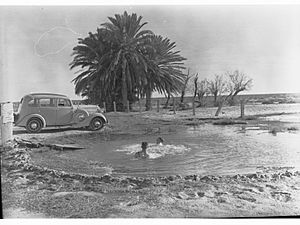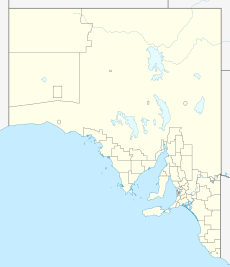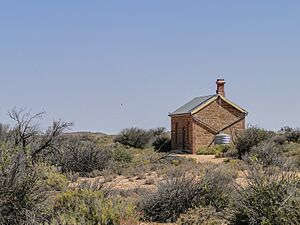Coward Springs facts for kids
Quick facts for kids Coward SpringsStuarts Creek, South Australia |
|
|---|---|

Coward Springs, ca. 1935
|
|
| Established | 1858 |
| Elevation | 18 m (59 ft) |
| Time zone | ACST (UTC+9:30) |
| • Summer (DST) | ACDT (UTC+10:30) |
| Location | 236 km (147 mi) east of Coober Pedy |
| State electorate(s) | Stuart |
| Federal Division(s) | Grey |
| Footnotes | Location |
Coward Springs is a special place in the Far North of South Australia. It used to be a railway station on the Central Australia Railway line. Today, it's known for its natural spring, called a "mound spring."
This unique spot is found along the Oodnadatta Track, close to the Wabma Kadarbu Mound Springs Conservation Park. It's about 236 kilometers (147 miles) from Coober Pedy.
Today, Coward Springs is a popular camping ground. Visitors can see old buildings, the original water bore, and lots of date palms and tamarisk trees.
Contents
What's in a Name? The Story of Coward Springs
In 1858, a police officer named Peter Warburton gave Coward Springs its name. He named it after Corporal Thomas Coward.
For many years, Coward Springs was officially known as a "locality," which is like a small town area. But in 2019, its official status changed to "mound spring." This change highlights its most important natural feature.
A Glimpse into the Past: History of Coward Springs
In 1886, the South Australian government drilled a deep hole here. This hole, called a borehole, was about 120 meters (400 feet) deep. Water from the Great Artesian Basin then shot up about 4.5 meters (15 feet) above the ground!
The water was salty, which caused the bore's metal parts to rust. This made the water flow freely, creating a large pool. By the 1920s, this pool had turned into a wetland in the middle of the dry, rocky plain.
This wetland became a favorite spot for local people. Train crews and passengers also loved to cool off there. Back then, train schedules allowed for delays, so people had time to enjoy the water.
In 1993, the government fixed the bore. They redrilled it and added a new lining to control the water flow. After this, the camping ground operators built a "natural spa" that looked like the old pool. Water from this spa was then sent into the wetland.
The wetland became an important oasis. It provided water, food, shelter, and breeding areas for many animals. By 2008, people had recorded 99 types of plants and 126 types of birds here. Many small native mammals, reptiles, and insects also lived there.
A school opened at Coward Springs in 1888, but it closed just two years later in 1890. The Coward Springs Hotel was open for a much longer time, from 1887 to 1953. When trains arrived, passengers were told where to find the "pub" for drinks or the "bath" for a swim.
Camping and Heritage: What to See Today
As of 2020, Coward Springs is run privately as a camping ground and a heritage area. This means it's a place where history is protected and shared.
In 1998, the "Coward Springs railway site" was added to the South Australian Heritage Register. This register lists important historical places. The site is special because it shows what an outback railway stop was like in South Australia. It was a key stop for passengers traveling to Oodnadatta and a place for livestock and supplies.
The date palms and tamarisk trees at the site are also important. The date palms remind us of early farming efforts in the outback. The tamarisk trees are good examples of plants brought in that can grow well in dry conditions.
You can see two restored stone railway buildings at Coward Springs. One was the stationmaster's house, and the other was for the train crews. There are also two underground rainwater tanks, the original bore, and the date palms and tamarisk trees.
Many people thought the date palms were planted by early "Afghan" cameleers. However, they are actually from an experimental farm. In 1898, the South Australian government planted two acres of date palms here. The palms that are still alive today continue to produce fruit!
Images for kids






